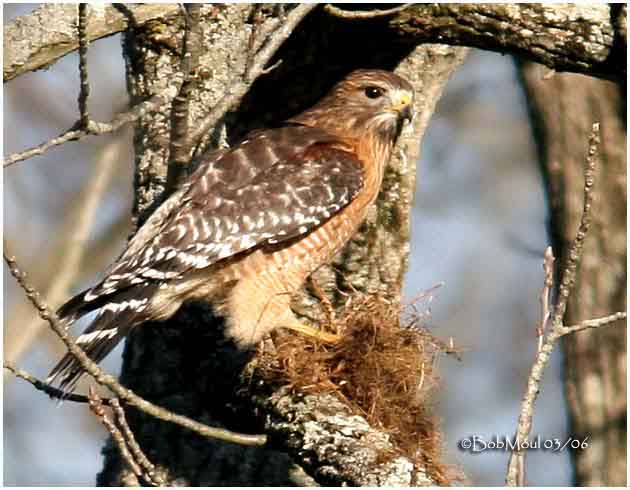
Buteo lineatus
Red-shouldered Hawk
Accipitriforme Order – Accipitridae Family
BIOMETRICS:
Length: 43-61 cm
Wingspan: 92-107 cm
Weight: 500-700 g
LONGIVITY: up to 20 years

DESCRIPTION:
Red-shouldered Hawk is large. It is a broad-winged hawk, with long tail and heavy body. Adult has brown head, dark brown back and reddish underparts, with dark brown streaks. It has reddish shoulders and wings linings, and extensive pale spotting above. It shows dark streaks on the reddish chest.
Female is similar in plumage but larger than male.
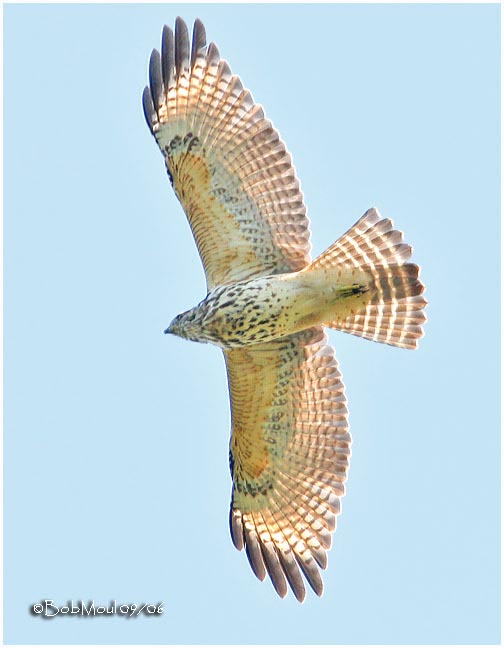
Juvenile shows extensive variations. Buteo lineatus presents more finely streaked breast than others subspecies. It has creamy underparts with dark spots and streaks. The tail of both adult and juvenile is dark brown with white bands.
Bill has yellow cere and black tip. Legs and feet are yellow. Eyes are brown.
VOICE: SOUNDS BY XENO-CANTO
Red-shouldered Hawk’s call is an evenly spaced series of clear and high notes “kee-ah” or “kah”. It is the most common call. This call announces that a territory is occupied, and when birds are alarmed. Seven different calls are recognized.
HABITAT:
Red-shouldered Hawk is often seen near water. It likes moist mixed woodlands. They prefer to have dead trees nearly, to perch and enjoy a good view of the ground.
RANGE:
North America to central Mexico. It breeds throughout eastern and northeast US, into southern Canada, and west of the Sierra Nevada in California. Populations in the eastern US and California are resident. Populations breeding in the northeast US and southern Canada migrate to northern Mexico to winter.
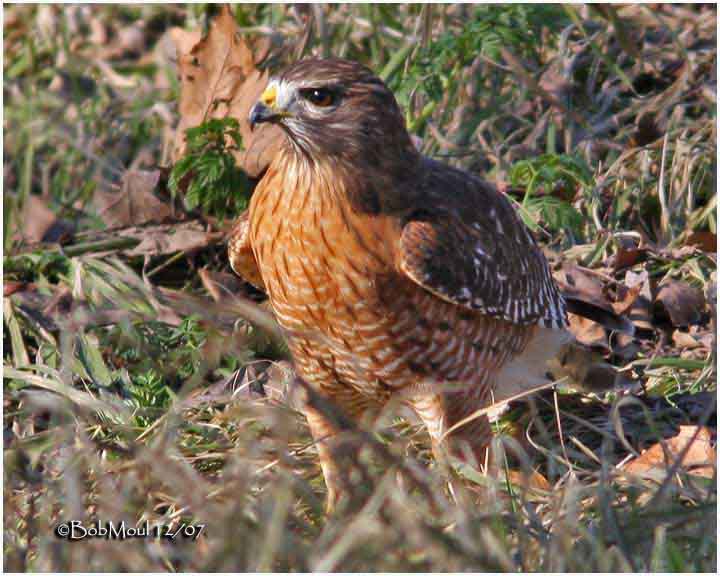
BEHAVIOUR:
Red-shouldered Hawk is solitary and territorial. They don’t form flocks even in winter.
Red-shouldered Hawk male has a larger home range than female. Territory of both sexes is usually larger during winter than during the breeding season. (From 1 to 3, 4 square kilometres)
These birds use physical displays, such as courtship flights, and vocalizations to communicate.
Red-shouldered Hawk searches for prey while perched at tree-top, or soaring over woodlands. When it sees a prey, it kills it by dropping directly onto it from the air.
They can cache food near their nest for later. They use sight and hearing to hunt, but they do not smell.
The shape and structure of the wings allow them to soar easily for long periods, searching for prey. The hawk’s large eyes are situated to look forward. The birds must turn their heads to keep prey in view. They have a very sharp vision.
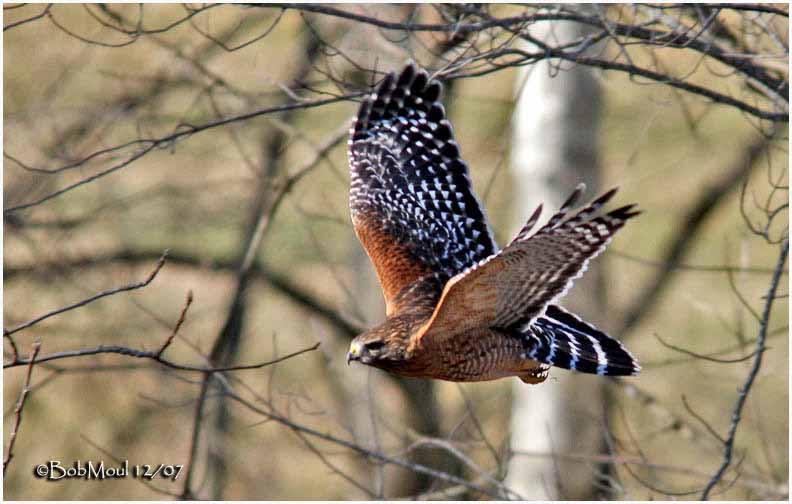
Red-shouldered Hawks are monogamous. Courtship displays begin on the breeding grounds. They soar together in broad circles while calling, or they soar and dive toward one another. Male may performs a “sky-dance”, by soaring high in the air, and making some series of steep dives, followed by a wide spiral and rapid ascent. These flights occur in late morning and early afternoon.
FLIGHT:
Red-shouldered Hawk flies with slow wing-beats. But it can perform active flight, with series of rapid wing-beats followed by glides. When soaring, the Red-shouldered Hawk bows its wings forward.
REPRODUCTION:
Red-shouldered Hawk breeds once per year, between April to July. They often use the same nest from year to year. Both male and female build or rework the nest. The nest is large and deep, constructed from sticks, twigs, shredded bark, leaves and green sprigs.
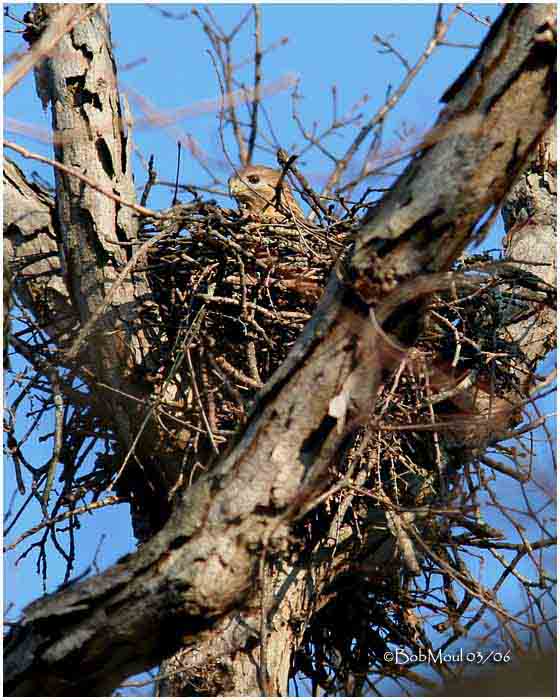
The female lays 3 to 4 white eggs with brown blotches, on 2-3 days. Incubation lasts for about 33 days, and begins with the first or second egg. Both parents incubate the eggs. Nestlings are brooded nearly constantly by female for at least a week. The male hunts and brings food to the nest for female and nestlings, during nestling period, about approximately 6 weeks. Chicks are fed by both parents during 8 to 10 weeks more. They become independents at 17 to 19 weeks old. They may still roost in or near the nest at night. They begin breeding when they are 1 year old or later.
DIET:
Red-shouldered Hawk’s diet consists primarily of small mammals, such as rabbits and squirrels. They also takes reptiles and amphibians, such as snakes, lizards and frogs, and small birds and large insects too. They like crayfish in some regions.
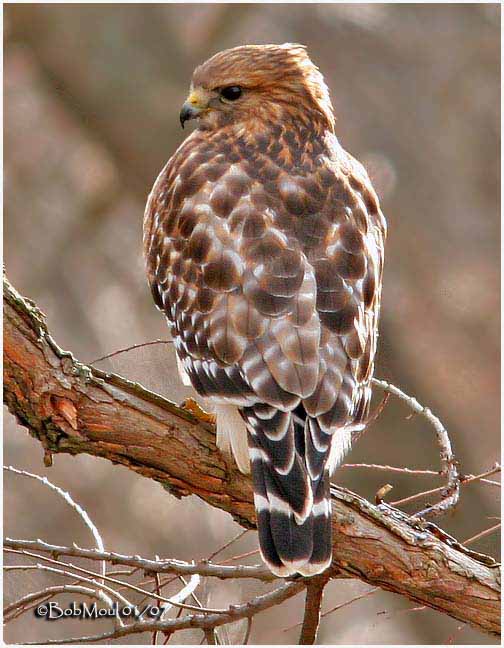
PROTECTION / THREATS / STATUS:
Red-shouldered Hawk adult, nestlings and eggs are vulnerable to predation by Great-horned Owls and raccoons, overall during incubation.
Occasionally, Red-shouldered Hawk attacks poultry, making them a nuisance to farmers who kill many of these hawks every year for this reason. But this bird preys on rodents that are agricultural nuisance.
Populations of Red-shouldered Hawks declined, probably due to hunting and loss of wet woodlands habitat. Poisoning from insecticides and industrial pollutants are major threats to this species.
Fr: Buse à epaulettes
All : Rotschulterbussard
Esp: Busardo Hombrorrojo
Ital: Poiana spallerosse
Nd: Roodschouderbuizerd
Russe: Канюк красноплечий
Sd: Bandvingad vråk
Photographs by Bob Moul
His website: Nature Photography
Text by Nicole Bouglouan
Sources :
HANDBOOK OF THE BIRDS OF THE WORLD Vol 2 by Josep del Hoyo-Andrew Elliot-Jordi Sargatal - Lynx Edicions - ISBN: 8487334156
FIELD GUIDE TO THE BIRDS OF NORTH AMERICA - National Geographic Society - ISBN: 0792274512
THE HANDBOOK OF BIRD IDENTIFICATION FOR EUROPE AND THE WESTERN PALEARCTIC by Mark Beaman, Steve Madge - C.Helm - ISBN: 0713639601
All About Birds (Cornell Lab of Ornithology)
Animal Diversity Web (University of Michigan Museum of Zoology)
What Bird-The ultimate Bird Guide (Mitchell Waite)
Wikipedia (Wikipedia, The Free Encyclopedia)
The Hawk Conservancy Trust (Hilary Smith)